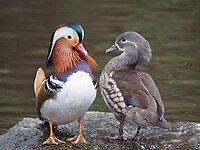
Photo from wikipedia
Cylindrus obtusus is an endemic land snail of the northeastern Alps. Early studies reported geographic differences in shell size and genital anatomy. Later, molecular genetic studies revealed that the species… Click to show full abstract
Cylindrus obtusus is an endemic land snail of the northeastern Alps. Early studies reported geographic differences in shell size and genital anatomy. Later, molecular genetic studies revealed that the species is differentiated into genetic lineages according to geographic region, named West, Central and East clades. In microsatellite analyses, these clades proved to be different with respect to heterozygosity and Hardy– Weinberg equilibrium. In populations from the eastern part of the distributional range all loci displayed an extreme excess of homozygotes, suggesting that selfing might be the predominant reproductive mode. In the present study, we analysed a comprehensive sample with respect to shell morphology as well as anatomical and histological traits. The analysed specimens were the same as those that had been studied genetically in a previous study. We tested whether the differentiation of the geographic groups is statistically significant. A morphometric analysis of the shells verified significant differences in shell height (SH) between two geographical groups (West/Central vs East). Moreover, we detected concordant significant geographic differences in the size and symmetry of the mucous glands. In the eastern populations, the glands were much smaller and asymmetrical in length and much more variable. In addition, the stylophore was significantly shorter. There was no correlation between these characters and shell size. Furthermore, love-darts were more frequently present in eastern populations. A comparative histological analysis revealed no significant differences in the cell structure of the mucous glands between the two geographic groups. Moreover, the presence of darts in the eastern populations does not indicate any dysfunction of these structures. Gland size, however, might influence the amount of secretion. Altogether, the results show consistent geographic differences in shell morphology and genital anatomy. The results corroborate the assumption of an altered mode of reproduction (predominantly via selfing) in eastern populations.
Journal Title: Journal of Molluscan Studies
Year Published: 2017
Link to full text (if available)
Share on Social Media: Sign Up to like & get
recommendations!